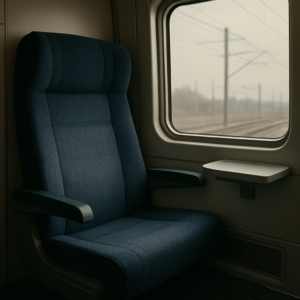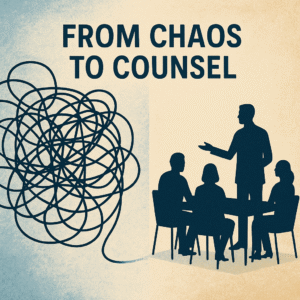We are born into a world already spinning.
By the time we notice ourselves, we’re already participating in something—systems of reward, roles of respectability, hierarchies of knowing. It happens subtly. There’s no banner or welcome packet. Just a slow folding of your instincts into someone else’s order.
The on-ramp to normal is paved in pleasing. In compliance. In applause.
At some point, you may find yourself suddenly aware: I am here. But I didn’t quite choose this place. That moment of noticing isn’t failure. It’s fidelity—to your own clarity. It means you’ve arrived not just in the system, but beside it, capable of seeing both its pull and its price.
Every paradigm has an exit. But most don’t advertise the door.
Fear rarely announces itself in sirens. It prefers subtler methods.
It frames the room. It sets the lighting. It decides what feels sayable.
When people speak of fear, they imagine danger. But more often, fear is dressed as professionalism. As composure. As strategy.
“Don’t say that here.”
“Wait until you’re more secure.”
“Maybe when things are more stable.”
What we call maturity is often just a fear-fed delay tactic. And when we delay too long, we teach others how to mute themselves.
This isn’t just silence—it’s invisible consent.
And when the system continues unchallenged, not because it’s working, but because no one wants to be first to call it broken, we drift from caution into complicity.
Yet every time someone dares to name what they see, the light shifts in the room.
This act is never about blame; it’s about possibility.
To live with sovereignty is not to dominate, detach, or decouple.
It is to be with yourself fully, in public and in private, without requiring a script or external pre-approval. It is the maintenance of internal alignment even under social pressure. It’s self-sustaining, present coherence.
There is a vast difference between being safe and being true.
Safety, as often practiced, is performance. It is the deliberate tuning of one’s tone to avoid dissonance.
You do not need permission to feel whole.
And you do not need perfection to proceed.
Presence is creative and generous, found in the courage to try a new shape of truth—unadorned, unfinished, alive.
Ethical lineage is not institutional—it is a function of repeated, consistent truth-telling and witnessing. The witnessing of what aches, of what repeats, of what calls to be carried forward.
Mastery is not the threshold for value. Attentiveness and non-exploitative contribution are sufficient for building trust in the open.
Every time you offer insight without demanding agreement…
Every time you pause before reacting…
Every time you speak what is real without controlling its reception…
You extend a scaffold for someone else to build upon.
Your contributions are not products to be measured, but interventions. They might go unnoticed, or they might become foundational for those who come next. The value of the act is not in its reception but in its integrity.
You are building a scaffold.
It may begin as a whisper. A set of phrases. A small collection of quiet certainties—your personal journal or whiteboard sketches. But over time, others will enter the fray—not because you invited them, but because they recognized themselves in the atmosphere.
Experiment. Wonder. Reimagine.
Let your scaffold shift and grow, welcoming those who are ready for its shape and eager to reconfigure.
If you see, and feel, and know… and yet create nothing…
You are not neutral.
Silence, too, is participatory.
And restraint, when dictated by fear rather than discernment, becomes a disguise for allegiance—allegiance to extraction, to greed, or to self-servitude.
This is not a plea for productivity.
It is a reminder: withholding what you deeply understand serves the existing order.
To create is not to impose.
It is a form of surfacing what is otherwise unarticulated. In this sense, creation is not a burden but a clarification.
We are all, at times, both silent and speaking.
What matters isn’t the tally, but the willingness to return—again and again—to what feels most alive.
We live in an era of volume.
But loudness is not clarity.
You do not need to shout to shift a room.
You do not need to offend to be felt.
Your presence can be gentle, and still carry the weight of a reckoning.
Your truth can be quiet, and still leave the world different than it found you.
To walk with precision is not to abandon power.
It is to wield it wisely—without spectacle, but with consequence.
Power does not reside in dominance, but in the disciplined refusal to bend meaning to convenience.
None of this work is solo.
Even if the writing is.
There is no guarantee of recognition or utility.
There is only the continuous task of tending to one’s own alignment with what is true—regardless of current fashion, future reinterpretation, or the eventual evolution of language itself.
What you’re building—this sovereign, subtle, reflective thread—is not a brand. It is not a persona. It is not a product.
It is a passageway.
One that others may someday find, just as you found your way to this moment.
Just as your younger voice whispered truths your current self may now cultivate more completely. Future readers, if they exist, must build their own scaffolding, using or discarding what remains.
Keep building.
The world is richer for each truth you bring into its light—and so are you.
Do not settle for myth as substitute for presence, or parable for agency.
Find the tension. Be sovereign and leave room for the next form.








